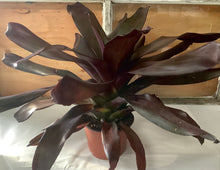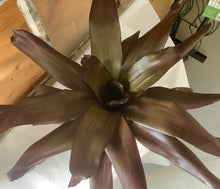A very dark green background with deep dark purple blush and green spots that turns to a very deep purple with age. A very striking combination of colors. A medium to large sized cross attaining mature sizes of up to 16" - 18" across.
Bromeliad is a well-known tropical epiphyte plant, growing in the ground and also on other stuff like rainforest trees, logs, rocks, and other plants. Popular as a striking houseplant with a lifespan of about 2 to 3 years, bromeliad comes with broad, succulent leaves and colorful foliage, flowering only once in its entire lifetime. The flowers last for about 3 to 6 months (sometimes longer). After a healthy bloom, the plant stops growing and begins producing offshoots called pups, visible at the base, giving the impression of a secondary bloom.
Exposure: For best results, put your bromeliad in a spot where it gets medium to bright light.
Water: One thing that’s different about bromeliad plant care than other plants is that you don’t want to water your bromeliads through the soil, instead you should keep their center cup filled with water, and their soil dry.
Humidity: Bromeliads like humid air, so consider misting your plants on a regular basis if the air in your home is dry. You could grow your bromeliad houseplant in rooms that are more humid, like a bathroom or in the kitchen close to the sink.
Fertilizer: Bromeliads don’t really need to be fertilized. They are naturally slow-growing plants, and fertilizer isn’t going to help them grow much faster. But, like any plant, bromeliads will benefit from getting some added nutrients – just make sure to fertilizer sparingly. Also, be sure to always use a natural organic liquid fertilizer, because bromeliads are very sensitive to chemical plant fertilizer.
Soil: Bromeliads could be mounted on logs, wood or rocks, or they can be grown in a pot. If you prefer to grow bromeliads in pots, you can buy bromeliad soil mix, or use an orchid soil mix.




